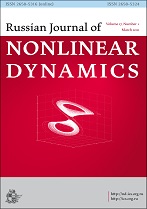|
Nonlinear physics and mechanics
Mathematical Model of Satellite Rotation near
Spin-Orbit Resonance 3:2
A. V. Shatinaa, M. I. Djioevaa, L. S. Osipovab
a MIREA – Russian Technological University,
pr. Vernadskogo 78, Moscow, 119454 Russia
b Lomonosov Moscow State University
ul. Vorobjevy gory 1, Moscow, 119992 Russia
Аннотация:
This paper considers the rotational motion of a satellite equipped with flexible viscoelastic
rods in an elliptic orbit. The satellite is modeled as a symmetric rigid body with a pair of
flexible viscoelastic rods rigidly attached to it along the axis of symmetry. A planar case is
studied, i. e., it is assumed that the satellite’s center of mass moves in a Keplerian elliptic orbit
lying in a stationary plane and the satellite’s axis of rotation is orthogonal to this plane. When
the rods are not deformed, the satellite’s principal central moments of inertia are equal to each
other. The linear bending theory for thin inextensible rods is used to describe the deformations.
The functionals of elastic and dissipative forces are introduced according to this model. The
asymptotic method of motions separation is used to derive the equations of rotational motion
reflecting the influence of the fluctuations, caused by the deformations of the rods. The method
of motion separation is based on the assumption that the period of the autonomous oscillations
of a point belonging to the rod is much smaller than the characteristic time of these oscillations’
decay, which, in its turn, is much smaller than the characteristic time of the system’s motion as
a whole. That is why only the oscillations induced by the external and inertial forces are taken
into account when deriving the equations of the rotational motion. The perturbed equations are
described by a third-order system of ordinary differential equations in the dimensionless variable
equal to the ratio of the satellite’s absolute value of angular velocity to the mean motion of the
satellite’s center of mass, the angle between the satellite’s axis of symmetry and a fixed axis
and the mean anomaly. The right-hand sides of the equation depend on the mean anomaly
implicitly through the true anomaly. A new slow angular variable is introduced in order to
perform the averaging for the perturbed system near the 3:2 resonance, and the averaging is
performed over the mean anomaly of the satellite’s center of mass orbit. In doing so the well-known expansions of the true anomaly and its sine and cosine in powers of the mean anomaly
are used. The steady-state solutions of the resulting system of equations are found and their
stability is studied. It is shown that, if certain conditions are fulfilled, then asymptotically stable
solutions exist. Therefore, the 3:2 spin-orbital resonance capture is explained.
Ключевые слова:
Keplerian elliptical orbit, satellite, spin-orbit resonance, dissipation.
Поступила в редакцию: 14.03.2022
Принята в печать: 08.07.2022
Образец цитирования:
A. V. Shatina, M. I. Djioeva, L. S. Osipova, “Mathematical Model of Satellite Rotation near
Spin-Orbit Resonance 3:2”, Rus. J. Nonlin. Dyn., 18:4 (2022), 651–660
Образцы ссылок на эту страницу:
https://www.mathnet.ru/rus/nd817 https://www.mathnet.ru/rus/nd/v18/i4/p651
|

|




 Обратная связь:
Обратная связь: Пользовательское соглашение
Пользовательское соглашение
 Регистрация посетителей портала
Регистрация посетителей портала Логотипы
Логотипы








 Цитирование в формате
Цитирование в формате 